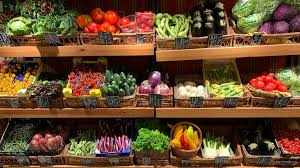In the past few years, organic food has grown from a niche choice to a major part of everyday shopping in the United States. Whether it’s produce, dairy, snacks, or drinks, more Americans are now buying food that is free from harmful chemicals, GMOs, and synthetic additives. Grocery stores across the country are responding fast—expanding their organic sections, introducing new brands, and catering to a growing demand for clean, eco-friendly, and sustainable food.
But what exactly is driving this organic movement? And which organic food trends are shaping grocery store shelves in 2025?
Let’s explore the top organic food trends taking over U.S. grocery stores and why more Americans are making the switch.

1. Plant-Based Organic Foods Are Booming
One of the biggest shifts in American food habits is the rise of plant-based organic products. Consumers are choosing organic plant-based alternatives not only for health reasons but also for environmental concerns. Products like organic almond milk, oat milk, plant-based cheeses, and meat substitutes are now found in almost every major grocery chain.
Organic plant-based brands are focusing on clean labels, fewer ingredients, and better taste. With growing awareness around animal welfare and climate change, this trend is here to stay.
2. Organic Snacks and Clean Label Packaged Foods
Gone are the days when snacks were only about taste. Today’s consumers want snacks that are both tasty and healthy. Organic snack brands are offering everything from kale chips and quinoa puffs to gluten-free cookies and organic trail mixes.
A major trend here is the “clean label” movement—products that are made with ingredients people can recognize and trust. Look at the packaging of top-selling organic snacks and you’ll see phrases like “no artificial preservatives,” “non-GMO,” and “made with real ingredients.”

3. Regenerative Organic Farming Gets Spotlight
It’s not just about being organic anymore; it’s about how the food is grown. Regenerative organic farming focuses on improving soil health, reducing carbon emissions, and supporting biodiversity.
Many US brands now promote products labeled as “regeneratively grown” or “certified regenerative organic.” Grocery stores are showcasing these labels more clearly to help customers make informed choices. This growing focus adds value to organic foods and aligns with the public’s rising interest in sustainability.
4. Organic Baby Food and Kids’ Products on the Rise
Health-conscious parents are prioritizing organic options for babies and young children. As a result, sales of organic baby food, cereals, formula, and snacks are rising in the U.S.
Brands offering transparent sourcing, BPA-free packaging, and non-GMO certifications are gaining popularity. Major retailers like Walmart, Target, and Whole Foods have expanded their organic baby product sections, responding to this family-first demand.
5. Frozen Organic Foods Gain Popularity
For years, frozen foods were considered less healthy. But that image is changing fast—especially with the rise of organic frozen options. Busy families and working professionals are now turning to frozen meals that offer both convenience and clean ingredients.
Items like organic frozen veggies, fruit blends for smoothies, ready-to-eat organic bowls, and even frozen pizzas with organic toppings are becoming weekly staples in American households.
6. Organic Spices, Condiments, and Pantry Staples
It’s not just fresh food—people are upgrading their entire kitchen with organic versions of everyday pantry items. Organic olive oil, honey, ketchup, mustard, herbs, and spices are now easily available in local supermarkets.
Consumers are paying closer attention to labels, looking for products free from artificial flavorings, colors, and preservatives. Even store-brand products are offering organic options to keep up with this demand.

7. Transparency and Traceability Matter More Than Ever
Modern shoppers want to know where their food comes from. They’re not just buying organic—they want proof. This has led to a trend of QR codes, tracking apps, and detailed labeling on organic food packages.
Grocery chains are partnering with local farms and small producers to ensure quality and build trust. This transparency not only builds brand loyalty but also educates consumers about the journey from farm to shelf.
8. Local Organic Brands Are Gaining Traction
While national organic brands still dominate, there is growing support for local and regional organic producers. Consumers prefer buying from brands that source ingredients nearby, reducing the carbon footprint and supporting community agriculture.
Many U.S. grocery stores now dedicate shelf space to “Local Organic” products, giving small farms a chance to shine and build loyal customer bases.
What’s Driving the Organic Food Boom?
Several factors are behind the rise of organic food in U.S. grocery stores:
- Health awareness: More people are choosing food that’s chemical-free and nutrient-rich.
- Environmental concerns: Consumers want sustainable farming practices and eco-friendly packaging.
- Food safety: Avoiding harmful pesticides and GMOs is a top priority.
- Social values: Buyers support brands that care for animal welfare, fair trade, and community farmers.
Final Thoughts
The organic food revolution in the USA is no longer just a trend—it’s a lifestyle shift. From fresh produce to packaged goods, American grocery stores are evolving to meet the changing needs of mindful consumers. As the demand continues to rise, expect more innovation, better labeling, and stronger support for sustainable agriculture.
Whether you’re a health enthusiast, an eco-conscious shopper, or just someone looking for cleaner food choices, the organic aisles in your local grocery store are full of exciting, healthy options waiting to be explored.
Also Read:- 10 High-Paying Side Hustles for US Residents in 2025


